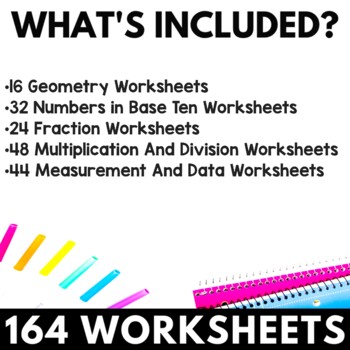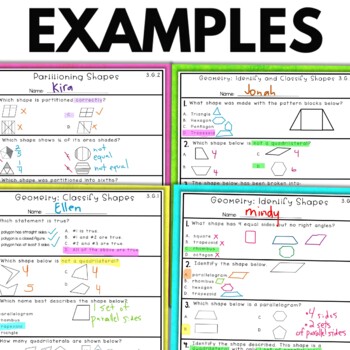3rd Grade Math Worksheets | Multiple Choice Bundle
- Zip
What educators are saying
Products in this Bundle (6)
showing 1-5 of 6 products
Description
This 164 math worksheets multiple choice bundle is perfect practice when teaching all 3rd grade common core math standards. All of the third grade math worksheets were made with state testing in mind and require critical thinking in order to solve. These 3rd grade math worksheets are perfect to use as worksheets, extra practice, quizzes, assessments, or remediation.
By purchasing this bundle, you are saving 30% off the price of the individual units.
Check out a free sample of this resource here!
⭐What's Included?⭐
-16 geometry worksheets (3.G.1 - 3.G.2)
-32 numbers in base ten worksheets (3.NBT.1 - 3.NBT.3)
-24 fraction worksheets (3.NF.1 - 3.NF.3)
-48 multiplication and division worksheets (3.OA.1 - 3.OA.9)
-44 measurement and data worksheets (3.MD.1 - 3.MD.8)
This bundles includes:
Third Grade Multiplication and Division Multiple Choice Worksheets
Third Grade Measurement and Data Multiple Choice Worksheets
Third Grade Geometry Multiple Choice Worksheets
Third Grade Fractions Multiple Choice Worksheets
Third Grade Numbers in Base Ten Multiple Choice Worksheets
⭐2 Formats Included!⭐
Every classroom is different. Choose the format that works for you! You may want to use these as a quick check or as math unit assessments. To make things easier on you, two formats are included. The first format includes 5 question worksheets that are easy to give in a short period of time and quickly tell you what your students are struggling with. The second format includes 10 question worksheets where students solve more questions and work for a longer period of time. Both versions are the same math material--just numbered differently to help you!
⭐Easy to Use⭐
With the skill and Common Core standard listed at the top of each page, it's easy to find which page you need and print! They are no-prep math assessments and ready to go from the time you download.
⭐Suggestions for Use⭐
With four pages per skill provided, these third grade math worksheets are perfect as math assessments, quick checks, quizzes, homework, remediation materials, extra practice, work to send home, pre-assessments, post assessments, unit tests, and more.
✅164 math worksheets
✅ multiple choice for test prep
✅encourage critical thinking
✅4 worksheets per math skill
✅comes in 2 formats: 5 questions and 10 questions
✅answer keys are included
✅3rd grade Common Core aligned
✅ made to align with 3rd grade math EOG in NC
This aligns with 1st Grade Texas TEKS:
- TEKS 1.6A: classify and sort regular and irregular two-dimensional shapes based on attributes using informal geometric language
- TEKS 1.6C: create two-dimensional figures, including circles, triangles, rectangles, and squares, as special rectangles, rhombuses, and hexagons
- TEKS 1.6D: identify two-dimensional shapes, including circles, triangles, rectangles, and squares, as special rectangles, rhombuses, and hexagons and describe their attributes using formal geometric language
This aligns with 2nd Grade Texas TEKS:
- TEKS 2.3A: partition objects into equal parts and name the parts, including halves, fourths, and eighths, using words
- TEKS 2.3B: explain that the more fractional parts used to make a whole, the smaller the part; and the fewer the fractional parts, the larger the part
- TEKS 2.3D: identify examples and non-examples of halves, fourths, and eighths
- TEKS 2.6A: model, create, and describe contextual multiplication situations in which equivalent sets of concrete objects are joined
- TEKS 2.6B: model, create, and describe contextual division situations in which a set of concrete objects is separated into equivalent sets
- TEKS 2.9F: use concrete models of square units to find the area of a rectangle by covering it with no gaps or overlaps, counting to find the total number of square units, and describing the measurement using a number and the unit
- TEKS 2.9G: read and write time to the nearest one-minute increment using analog and digital clocks and distinguish between a.m. and p.m.
This aligns with 3rd Grade Texas TEKS:
- TEKS 3.3A: represent fractions greater than zero and less than or equal to one with denominators of 2, 3, 4, 6, and 8 using concrete objects and pictorial models, including strip diagrams and number lines
- TEKS 3.3B: determine the corresponding fraction greater than zero and less than or equal to one with denominators of 2, 3, 4, 6, and 8 given a specified point on a number line
- TEKS 3.3C: explain that the unit fraction 1/b represents the quantity formed by one part of a whole that has been partitioned into b equal parts where b is a non-zero whole number
- TEKS 3.3E: solve problems involving partitioning an object or a set of objects among two or more recipients using pictorial representations of fractions with denominators of 2, 3, 4, 6, and 8
- TEKS 3.3F: represent equivalent fractions with denominators of 2, 3, 4, 6, and 8 using a variety of objects and pictorial models, including number lines
- TEKS 3.3G: explain that two fractions are equivalent if and only if they are both represented by the same point on the number line or represent the same portion of a same size whole for an area model
- TEKS 3.3H: compare two fractions having the same numerator or denominator in problems by reasoning about their sizes and justifying the conclusion using symbols, words, objects, and pictorial models
- TEKS 3.4A: solve with fluency one-step and two-step problems involving addition and subtraction within 1,000 using strategies based on place value, properties of operations, and the relationship between addition and subtraction
- TEKS 3.4B: round to the nearest 10 or 100 or use compatible numbers to estimate solutions to addition and subtraction problems
- TEKS 3.4D: determine the total number of objects when equally-sized groups of objects are combined or arranged in arrays up to 10 by 10
- TEKS 3.4E: represent multiplication facts by using a variety of approaches such as repeated addition, equal-sized groups, arrays, area models, equal jumps on a number line, and skip counting
- TEKS 3.4F: recall facts to multiply up to 10 by 10 with automaticity and recall the corresponding division facts
- TEKS 3.4G: use strategies and algorithms, including the standard algorithm, to multiply a two-digit number by a one-digit number. Strategies may include mental math, partial products, and the commutative, associative, and distributive properties
- TEKS 3.4H: determine the number of objects in each group when a set of objects is partitioned into equal shares or a set of objects is shared equally
- TEKS 3.4J: determine a quotient using the relationship between multiplication and division
- TEKS 3.4K: solve one-step and two-step problems involving multiplication and division within 100 using strategies based on objects; pictorial models, including arrays, area models, and equal groups; properties of operations; or recall of facts
- TEKS 3.5A: represent one- and two-step problems involving addition and subtraction of whole numbers to 1,000 using pictorial models, number lines, and equations
- TEKS 3.5B: represent and solve one- and two-step multiplication and division problems within 100 using arrays, strip diagrams, and equations
- TEKS 3.5C: describe a multiplication expression as a comparison such as 3 x 24 represents 3 times as much as 24
- TEKS 3.5D: determine the unknown whole number in a multiplication or division equation relating three whole numbers when the unknown is either a missing factor or product
- TEKS 3.5E: represent real-world relationships using number pairs in a table and verbal descriptions
- TEKS 3.6B: use attributes to recognize rhombuses, parallelograms, trapezoids, rectangles, and squares as examples of quadrilaterals and draw examples of quadrilaterals that do not belong to any of these subcategories
- TEKS 3.6C: determine the area of rectangles with whole number side lengths in problems using multiplication related to the number of rows times the number of unit squares in each row
- TEKS 3.6D: decompose composite figures formed by rectangles into non-overlapping rectangles to determine the area of the original figure using the additive property of area
- TEKS 3.6E: decompose two congruent two-dimensional figures into parts with equal areas and express the area of each part as a unit fraction of the whole and recognize that equal shares of identical wholes need not have the same shape
- TEKS 3.7A: represent fractions of halves, fourths, and eighths as distances from zero on a number line
- TEKS 3.7B: determine the perimeter of a polygon or a missing length when given perimeter and remaining side lengths in problems
- TEKS 3.7C: determine the solutions to problems involving addition and subtraction of time intervals in minutes using pictorial models or tools such as a 15-minute event plus a 30-minute event equals 45 minutes
- TEKS 3.7D: determine when it is appropriate to use measurements of liquid volume (capacity) or weight
- TEKS 3.7E: determine liquid volume (capacity) or weight using appropriate units and tools
- TEKS 3.8A: summarize a data set with multiple categories using a frequency table, dot plot, pictograph, or bar graph with scaled intervals
- TEKS 3.8B: solve one- and two-step problems using categorical data represented with a frequency table, dot plot, pictograph, or bar graph with scaled intervals
This aligns with 4th Grade Texas TEKS:
- TEKS 4.3C: determine if two given fractions are equivalent using a variety of methods
- TEKS 4.3D: compare two fractions with different numerators and different denominators and represent the comparison using the symbols >, =, or <
- TEKS 4.5C: use models to determine the formulas for the perimeter of a rectangle (l + w + l + w or 2l + 2w), including the special form for perimeter of a square (4s) and the area of a rectangle (l x w)
- TEKS 4.5D: solve problems related to perimeter and area of rectangles where dimensions are whole numbers
- TEKS 4.8A: identify relative sizes of measurement units within the customary and metric systems
----------------------------------------------------------------------------------
GET THE DIGITAL VERSIONS HERE!
3rd Grade Numbers in Base Ten Digital Unit Assessments
3rd Grade Measurement and Data Digital Unit Assessments
3rd Grade Multiplication and Division Digital Unit Assessments
3rd Grade Fractions Digital Unit Assessments
3rd Grade Geometry Digital Unit Assessments
3rd Grade Digital Unit Assessments BUNDLE (Save 30%)
You may also like:
Third Grade Math Test Prep - The Floor is Lava Classroom Transformation
Third Grade Math Test Prep - Hawaiian Vacation Classroom Transformation
3rd Grade Math Worksheets Bundle - Constructed Response
----------------------------------------------------------------------------------
Other Information:
Follow me and be notified when new products are uploaded. New products are always 50% off for the first 24 hours they are posted.
Thank you so much,
The Lifetime Learner
Copyright information:
Purchasing this product grants permission for use by one teacher in his or her own classroom. If you intend to share with others, please purchase an additional license at a discount!
Questions?
Email me at lindsaythelifetimelearner@gmail.com





